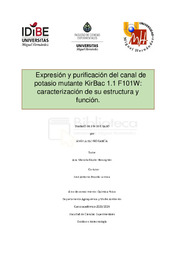Resumen :
En esta memoria se ha caracterizado la estructura y función de la proteína KirBac F101W,
mutante del canal modelo de potasio KirBac 1.1, a su vez análogo de los canales Kir eucariotas que
previamente fue estudiado por el grupo de investigación donde se ha desarrollado este trabajo. La
mutación de una fenilalanina por un triptófano en la posición 101 de la secuencia aminoacídica,
localizada en la hélice del poro del canal, dominio adyacente al filtro de selectividad, se realizó para
obtener información de la estructura de este a través de la monitorización de la emisión de fluorescencia
de ese triptófano. Primero, se expresó la proteína de forma heteróloga en bacterias E. Coli y se purificó.
Posteriormente, se estudió la estructura terciaria del canal mediante técnicas de fluorescencia
aprovechando la presencia de residuos de triptófano en el dominio C-terminal y del triptófano mutado.
Se midió el espectro de emisión de fluorescencia, así como la desnaturalización térmica de la proteína
en condiciones de pH 4 y pH 7, que inducen el cierre y apertura del canal, respectivamente, y con iones
Na+ y K+, no conductor y conductor respectivamente, con la finalidad de estudiar la influencia de estos
factores en la conformación del filtro de selectividad del canal. Los resultados indicaron que el canal
mutante se comporta estructural y funcionalmente de forma similar al canal nativo. El resultado más
relevante para esta memoria es que los espectros de emisión de fluorescencia intrínseca son sensibles
al tipo de ion presente en el medio. Este nuevo resultado se ha podido determinar con el canal mutante,
cosa que no se pudo hacer con el nativo, confirmándose que la mutación introducida sirve de “reporter”
de los cambios estructurales del filtro de selectividad del canal.
In this study, the structure and function of the KirBac F101W protein, a mutant of the model
potassium channel KirBac 1.1, which is an analogue of eukaryotic Kir channels previously studied by
the research group where this work was developed, have been characterized. The mutation involved
replaces a phenylalanine with a tryptophan at position 101 in the amino acid sequence, located in the
pore helix of the channel, adjacent to the selectivity filter domain. This was done to obtain structural
information by monitoring the fluorescence emission of this tryptophan. First, the protein was
heterologously expressed in E. coli bacteria and purified. Subsequently, the tertiary structure of the
channel was studied using fluorescence techniques, taking advantage of the presence of tryptophan
residues in the C-terminal domain and the mutated tryptophan. The fluorescence emission spectrum
and the thermal denaturation of the protein were measured under pH 4 and pH 7 conditions, which
induce channel closing and opening, respectively, and with Na+ and K+ ions, non-conductive and
conductive respectively, to study the influence of these factors on the conformation of the channel's
selectivity filter. The results indicated that the mutant channel behaves structurally and functionally
similarly to the wild-type channel. The most relevant finding of this study is that the intrinsic fluorescence
emission spectra are sensitive to the type of ion present in the medium. This new result could be
determined with the mutant channel, which was not possible with the wilt-type one, confirming that the
introduced mutation serves as a reporter of the structural changes in the channel selectivity filter.
|
 La licencia se describe como: Atribución-NonComercial-NoDerivada 4.0 Internacional.
La licencia se describe como: Atribución-NonComercial-NoDerivada 4.0 Internacional.
.png)
